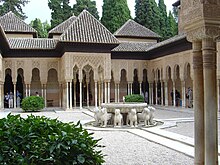Islamic Golden Age: Difference between revisions
there were multiple caliphates (at times even simultaneously) not single; restored some info into lede |
|||
| Line 1: | Line 1: | ||
[[File:Maqamat hariri.jpg|thumb||300px|Scholars at an Abbasid library. Maqamat of al-Hariri Illustration by Yahyá al-Wasiti, [[Baghdad]] 1237]] |
[[File:Maqamat hariri.jpg|thumb||300px|Scholars at an Abbasid library. Maqamat of al-Hariri Illustration by Yahyá al-Wasiti, [[Baghdad]] 1237]] |
||
The '''Islamic Golden Age''' refers to the period during the [[history of Islam]] when the [[Muslim world]] was politically united under |
The '''Islamic Golden Age''' refers to the period during the [[history of Islam]] when the [[Muslim world]] was politically united under [[caliphate]]s, experiencing a [[Islamic science|scientific]] and cultural flourishing. |
||
This period is |
This period is sometimes taken to have lasted throughout the 9th to 12th centuries, and sometimes extended to include parts of the 8th and 13th centuries. It began with the inauguration of the [[House of Wisdom]] in [[Baghdad]] during the reign of the [[Abbasid caliphate|Abbasid]] caliph [[Harun ar-Rashid]] (786 to 809), where scholars from various parts of the world sought to translate and gather all the known world's knowledge into [[Arabic language|Arabic]].<ref>Medieval India, NCERT, ISBN 81-7450-395-1</ref> <ref name="Vartan">Vartan Gregorian, "Islam: A Mosaic, Not a Monolith", Brookings Institution Press, 2003, pg 26–38 ISBN 0-8157-3283-X</ref> and it is mostly taken to have ended with the collapse of the Abbasid caliphate with the [[Mongol invasions]] and the [[Siege of Baghdad (1258)|Sack of Baghdad]] in 1258.<ref name="Tahir Abbas">{{cite book|title=Islamic Radicalism and Multicultural Politics|url=http://books.google.com/books?id=JdC90uc8PfQC&pg=PA9|accessdate=26 August 2012|publisher=Taylor & Francis|isbn=978-1-136-95960-8|page=9}}</ref> |
||
The Arabs showed a strong interest in assimilating the scientific knowledge of the civilizations they had conquered. Many classic works of antiquity that might otherwise have been lost were translated into Arabic and Persian and later in turn translated into Turkish, Hebrew, and Latin.<ref name="Vartan"/> They assimilated, synthesized, and advanced the knowledge gained from the ancient [[Ancient Greece|Greek]], [[Ancient Rome|Roman]], [[Persian Empire|Persian]], [[History of India|Indian]], [[History of China|Chinese]], [[Ancient Egypt|Egyptian]], and [[Phoenicia]]n civilizations.<ref name="Vartan"/> During the age, the major Islamic capital cities of Baghdad, [[Cairo]], and [[Córdoba, Andalusia#Islamic rule|Córdoba]] became the main intellectual centers for science, philosophy, medicine, trade, and education. |
|||
==History of the concept== |
==History of the concept== |
||
Revision as of 12:53, 24 October 2014
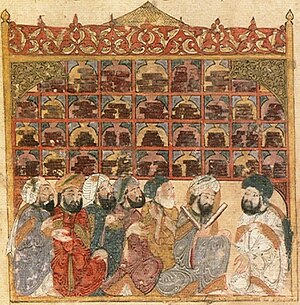
The Islamic Golden Age refers to the period during the history of Islam when the Muslim world was politically united under caliphates, experiencing a scientific and cultural flourishing. This period is sometimes taken to have lasted throughout the 9th to 12th centuries, and sometimes extended to include parts of the 8th and 13th centuries. It began with the inauguration of the House of Wisdom in Baghdad during the reign of the Abbasid caliph Harun ar-Rashid (786 to 809), where scholars from various parts of the world sought to translate and gather all the known world's knowledge into Arabic.[1] [2] and it is mostly taken to have ended with the collapse of the Abbasid caliphate with the Mongol invasions and the Sack of Baghdad in 1258.[3]
The Arabs showed a strong interest in assimilating the scientific knowledge of the civilizations they had conquered. Many classic works of antiquity that might otherwise have been lost were translated into Arabic and Persian and later in turn translated into Turkish, Hebrew, and Latin.[2] They assimilated, synthesized, and advanced the knowledge gained from the ancient Greek, Roman, Persian, Indian, Chinese, Egyptian, and Phoenician civilizations.[2] During the age, the major Islamic capital cities of Baghdad, Cairo, and Córdoba became the main intellectual centers for science, philosophy, medicine, trade, and education.
History of the concept

The metaphor of a golden age begins to be applied in 19th-century literature about Islamic history, in the context of the western cultural fashion of Orientalism. The author of a Handbook for Travelers in Syria and Palestine in 1868 observed that the most beautiful mosques of Damascus were "like Mohammedanism itself, now rapidly decaying" and relics of "the golden age of Islam". [4]
There is no unambiguous definition of term, and depending on whether it is used with a focus on cultural or on military achievement, it may be taken to refer to rather disparate time spans. thus, one author would have it extend to the duration of the caliphate, or to "six and a half centuries",[5] while another would have it end after only a few decades of Rashidun conquests, with the death of Umar and the First Fitna.[6]
During the early 20th century, the term was used only occasionally, and often referred to the early military successes of the Rashidun caliphs. It was only in the second half of the 20th century that the term came to be used with any frequency, now mostly referring to the cultural flourishing of science and mathematics under the caliphate during roughly the 9th to 11th centuries (between the establishment of organised scholarship in the House of Wisdom and the beginning of the crusades), [7] but often extended to include part of the late 8th or the 12th to early 13th centuries.[8] but definitions may still vary considerably. The end of the golden age with the end of the caliphate is a convenient cut-off point based on a historical landmark, but it can be argued that Islamic culture had entered a gradual decline much earlier; thus, Khan (2003) identifies as the golden age proper the two centuries between 750–950, arguing that the beginning loss of territories under Harun al-Rashid worsened after the death of al-Ma'mun in 833, and that the crusades in the 12th century resulted in a further weakening of the Abbasid empire from which it never recovered.[9]
Causes
The Abbasids were influenced by the Quranic injunctions and hadiths, such as "the ink of a scholar is more holy than the blood of a martyr," that stressed the value of knowledge.[2] During the Fatimid era (909–1171) Egypt became the center of an empire that included at its peak North Africa, Sicily, Palestine, Jordan, Lebanon, Syria, the Red Sea coast of Africa, Tihamah, Hejaz, and Yemen. During the age, the major Islamic capital cities of Baghdad, Cairo, and Córdoba became the main intellectual centers for science, philosophy, medicine, trade, and education. The Muslims during this period showed a strong interest in assimilating the scientific knowledge of the civilizations that had been conquered. Many classic works of antiquity that might otherwise have been lost were translated into Arabic and Persian and later in turn translated into Turkish, Hebrew, and Latin.[2] They assimilated, synthesized, and advanced the knowledge gained from the ancient Greek, Roman, Persian, Indian, Chinese, Egyptian, and Phoenician civilizations.[2]
Government sponsorship
The government heavily patronized scholars. The money spent on the Translation Movement for some translations is estimated to be equivalent to about twice the annual research budget of the United Kingdom’s Medical Research Council.[10] The best scholars and notable translators, such as Hunayn ibn Ishaq, had salaries that are estimated to be the equivalent of professional athletes today.[10]
New technology
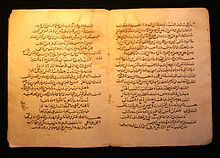
With a new, easier writing system and the introduction of paper, information was democratized to the extent that for probably the first time in history, it became possible to make a living from simply writing and selling books.[11] The use of paper spread from China into Muslim regions in the eighth century, arriving in Spain (and then the rest of Europe) in the 10th century. It was easier to manufacture than parchment, less likely to crack than papyrus, and could absorb ink, making it difficult to erase and ideal for keeping records. Islamic paper makers devised assembly-line methods of hand-copying manuscripts to turn out editions far larger than any available in Europe for centuries.[12] It was from these countries that the rest of the world learned to make paper from linen.[13]
Earlier cultural influence
Christians (particularly Nestorian Christians) contributed to the Arab Islamic Civilization during the Ummayad and the Abbasid periods by translating works of Greek philosophers to Syriac and afterwards to Arabic.[14][15][16] During the 4th through the 7th centuries, scholarly work in the Syriac and Greek languages was either newly initiated, or carried on from the Hellenistic period. Centers of learning and of transmission of classical wisdom included colleges such as the School of Nisibis and later the School of Edessa, and the renowned hospital and medical academy of Jundishapur; libraries included the Library of Alexandria and the Imperial Library of Constantinople; and other centers of translation and learning functioned at Merv, Salonika, Nishapur and Ctesiphon situated just south of what was later to become Baghdad.[17][18] The House of Wisdom was a library, translation institute and academy established in Abbasid-era Baghdad, Iraq.[19][20] Nestorians played a prominent role in the formation of Arab culture,[21] with the Jundishapur school being prominent in the late Sassanid, Umayyad and early Abbasid periods.[22] Notably, eight generations of the Nestorian Bukhtishu family served as private doctors to caliphs and sultans between the 8th and 11th centuries.[23][24]
Philosophy
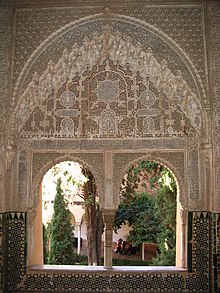
Ibn Rushd and Ibn Sina played a major role in saving the works of Aristotle, whose ideas came to dominate the non-religious thought of the Christian and Muslim worlds. Islamic scholars would also absorb ideas from China and India, adding to the tremendous knowledge from their own studies.[citation needed] Ibn Sina and other speculative thinkers such as al-Kindi and al-Farabi combined Aristotelianism and Neoplatonism with other ideas introduced through Islam.[citation needed] Arabic philosophic literature was translated into Latin and Ladino, contributing to the development of modern European philosophy. During this period non-Muslims were allowed to flourish relative to their treatment in the Christian Byzantine Empire. The Jewish philosopher Moses Maimonides, who lived in Andalusia, is an example.[citation needed]
Avicenna argued his "Floating Man" thought experiment concerning self-awareness, in which a man prevented of sense experience by being blindfolded and free falling would still be aware of his existence.[25]
Ibn Tufail wrote the novel Hayy ibn Yaqdhan and in response Ibn al-Nafis wrote the novel Theologus Autodidactus. Both were concerning autodidacticism as illuminated through the life of a feral child spontaneously generated in a cave on a desert island.
Science
Scientific method
Ibn Al-Haytham (Alhazen) was significant in the history of scientific method, particularly in his approach to experimentation,[26] and has been referred to by his modern biographer Bradley Steffens and others [27] as the "world’s first true scientist".
Jim Al-Khalili gives the example of the classification of materials as a sign of new ways of thinking.[28] While the classification of the material world by the ancient Greeks into Air, Earth, Fire and Water was more philosophical, medieval Islamic scientists used practical, experimental observation to classify materials.[28] Rhazes, for example, classified minerals into six groups based on their observed chemical properties; Spirits, which were flammable, Material Bodies, which were shiny and malleable, Vitriols, Stones, Salts, which could dissolve in water, and Boraxes.[28]
Mathematics

In calculus, Alhazen discovered the sum formula for the fourth power, using a method readily generalizable to determine the sum for any integral power. He used this to find the volume of a paraboloid. He could find the integral formula for any polynomial without having developed a general formula.[29]
In geometry, Medieval Islamic art from the 15th century intuitively echoed principles of quasicrytalline geometry, which were discovered 500 years later.[30][31] The art uses symmetric polygonal shapes to create patterns that, without leaving gaps, can continue indefinitely without repeating its pattern, in a way that can be directly compared to what are now considered quasi-crystals.[32] It was previously thought that Islamic design was done with straightedge rulers and compasses, but Lu and Steinhart now argue that the patterns were created by tessellating a small number of different tiles with complex shapes, evolving into what would now be described as quasi-periodic shapes by the 15th century.[31] The Swedish Academy, which granted Dan Shechtman the Nobel Prize in Chemistry for his discovery of quasicrystals in molecular structures, stated, "Aperiodic mosaics, such as those found in the medieval Islamic mosaics of the Alhambra Palace in Spain and the Darb-i Imam Shrine in Iran, have helped scientists understand what quasicrystals look like at the atomic level".[32]
In trigonometry, Ibn Muʿādh al-Jayyānī introduced the general Law of sines in his The book of unknown arcs of a sphere in the 11th century. This formula relates the lengths of the sides of an arbitrary triangle (not just limited to right triangles) to the sines of its angles.[33]
Physics
In about 964, Persian astronomer Abd al-Rahman al-Sufi writing in his Book of Fixed Stars, described a "nebulous spot" in the Andromeda constellation, the first definitive reference to what we now know is the Andromeda Galaxy, the nearest spiral galaxy to our galaxy.[34]
Biology
In his survey of the history of the ideas which led to the theory of natural selection, Conway Zirkle noted that al-Jahiz was one of those who discussed a "struggle for existence", in his Kitab al-Hayawan (Book of Animals), written in the 9th century.[35]
Medicine
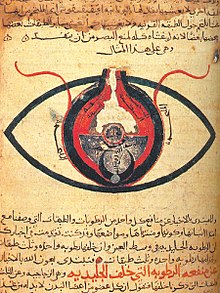
Islamic medicine was built on tradition, chiefly the theoretical and practical knowledge developed in India, Greece, Persia, and Rome. For Islamic scholars, Galen, Mankah, Sustura, and Hippocrates were pre-eminent authorities.[36] Islamic scholars translated their voluminous writings from Syriac, Greek, and Sanskrit into Arabic and then produced new medical knowledge based on those texts. In order to make the Greek tradition more accessible, understandable, and teachable, Islamic scholars ordered and made more systematic the vast and sometimes inconsistent Greco-Roman medical knowledge by writing encyclopaedias and summaries.
Ibn al-Nafis in his Commentary on Anatomy in Avicenna's Canon was the first to contradict the contention of the Galen School that blood could pass between the ventricles in the heart through the cardiac interventricular septum that separates them, saying that there is no passage between the ventricles at this point.[37] Instead, he correctly argued that all the blood that reached the left ventricle did so after passing through the lung.[37] Finally, he also stated that there must be small communications or pores between the pulmonary artery and pulmonary vein, a prediction that preceded by 400 years the discovery of the pulmonary capillaries by Marcello Malpighi. The Commentary was "rediscovered" in the 20th century in the Prussian State Library in Berlin; whether its view of the pulmonary circulation influenced scientists such as Michael Servetus is unclear, as it was not published and only five copies were made.[37]
Pagan Latin and Greek learning was viewed suspiciously in Christian early medieval Europe, and it was through 12th-century Arabic translations that medieval Europe rediscovered Hellenic medicine, including the works of Galen and Hippocrates. Of equal if not of greater influence in Western Europe were systematic and comprehensive works such as Avicenna's The Canon of Medicine, translated into Latin and then disseminated in manuscript and printed form throughout Europe. During the 15th and 16th centuries alone, The Canon of Medicine was published more than thirty-five times.
Institutions
Healthcare
Hospitals in this era were the first to require medical diplomas to license doctors.[38] In the medieval Islamic world, hospitals were built in most major cities.
Medical facilities traditionally closed each night, but by the 10th century laws were passed to keep hospitals open 24 hours a day, and hospitals were forbidden to turn away patients who were unable to pay.[39] Eventually, charitable foundations called waqfs were formed to support hospitals, as well as schools.[39] This money supported free medical care for all citizens.[39] In a notable example, a 13th-century governor of Egypt Al Mansur Qalawun ordained a foundation for the Qalawun hospital that would contain a mosque and a chapel, separate wards for different diseases, a library for doctors and a pharmacy.[40] The Qalawun hospital was based in a former Fatimid palace which had accommodation for 8,000 people.[41] "It served 4,000 patients daily."[42] The waqf stated,
"...The hospital shall keep all patients, men and women, until they are completely recovered. All costs are to be borne by the hospital whether the people come from afar or near, whether they are residents or foreigners, strong or weak, low or high, rich or poor, employed or unemployed, blind or sighted, physically or mentally ill, learned or illiterate. There are no conditions of consideration and payment, none is objected to or even indirectly hinted at for non-payment."[40]
The first institutions for the care of mentally ill people were also established.[43]
Education

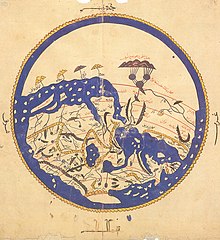
The Guinness World Records recognizes the University of Al Karaouine, founded in 859, as the world's oldest degree-granting university.[44]
The Al Azhar University was the first university in the East and perhaps the oldest in history. The madrasa is one of the relics of the Fatimid dynasty era of Egypt, descended from Fatimah, daughter of Muhammad. Fatimah was called Az-Zahra (the brilliant), and it was named in her honor. [citation needed] It was founded as mosque by the Fatimid commander Jawhar at the orders of the Caliph Al-Muizz as he founded the city for Cairo. It was (probably on Saturday) in Jamadi al-Awwal in the year 359 A.H. Its building was completed on the 9th of Ramadan in the year 361 A.H. Both Al-'Aziz Billah and Al-Hakim bi-Amr Allah added to its premises. It was further repaired, renovated and extended by Al-Mustansir Billah and Al-Hafiz Li-Din-illah. Fatimid Caliphs always encouraged scholars and jurists to have their study-circles and gatherings in this mosque and thus it was turned into a university which has the claim to be considered as the oldest University still functioning.[45]
The intellectual life in Egypt during Fatimid era reached a great degree of progress and activity due to the number of scholars who either lived in Egypt or came from outside as well as the number of books available. The Fatimid Caliphs gave prominent positions to the scholars in their courts and encouraged the students. Fatimids paid attention to establishing libraries in their palaces so that the scholars might polish up their knowledge and get benefit of what their predecessors had done.[45]
Commerce and travel
Apart from the Nile, Tigris, and Euphrates, navigable rivers were uncommon in the Middle East, so transport by sea was very important. Navigational sciences were highly developed, making use of a rudimentary sextant (known as a kamal). When combined with detailed maps of the period, sailors were able to sail across oceans rather than skirt along the coast. Muslim sailors were also responsible for reintroducing large, three-masted merchant vessels to the Mediterranean. The name caravel may derive from an earlier Arab boat known as the qārib.[46]
During the Fatimid era Egypt flourished, and the Fatimids developed an extensive trade network in both the Mediterranean and the Indian Ocean. Their trade and diplomatic ties extended all the way to China and its Song Dynasty, which eventually determined the economic course of Egypt during the High Middle Ages.
Unlike other governments in the area, Fatimid advancement in state offices was based more on merit than on heredity. Members of other branches of Islam, like the Sunnis, were just as likely to be appointed to government posts as Shiites. Tolerance was extended to non-sunnies such as Christians, Shias, and Jews,[47] who occupied high levels in government based on ability, and tolerance was set into place to ensure the flow of money from all those who were non-Muslims too in order to finance the Fatimids Caliphs' large army of Mamluks brought in from Circassia by Genoese merchants.[citation needed]
Culture
Art


The golden age of Islamic (and/or Muslim) art lasted from 750 to the 16th century, when ceramics (especially lusterware), glass, metalwork, textiles, illuminated manuscripts, and woodwork flourished.[citation needed] Manuscript illumination became an important and greatly respected art, and portrait miniature painting flourished in Persia. Calligraphy, an essential aspect of written Arabic, developed in manuscripts and architectural decoration.
The Fatimid era was also known for their exquisite arts. A type of ceramic, lustreware, was prevalent during the Fatimid period. Glassware and metalworking was also popular.
Architecture
The Great Mosque of Kairouan (in Tunisia), the ancestor of all the mosques in the western Islamic world,[48] is one of the best preserved and most significant examples of early great mosques. Founded in 670, it dates in its present form largely from the 9th century.[49] The Great Mosque of Kairouan is constituted of a three-tiered square minaret, a large courtyard surrounded by colonnaded porticos, and a huge hypostyle prayer hall covered on its axis by two cupolas.[48]
The Great Mosque of Samarra in Iraq was completed in 847. It combined the hypostyle architecture of rows of columns supporting a flat base, above which a huge spiralling minaret was constructed.
The beginning of construction of the Great Mosque at Cordoba in 785 marked the beginning of Islamic architecture in Spain and Northern Africa. The mosque is noted for its striking interior arches. Moorish architecture reached its peak with the construction of the Alhambra, the magnificent palace/fortress of Granada, with its open and breezy interior spaces adorned in red, blue, and gold. The walls are decorated with stylized foliage motifs, Arabic inscriptions, and arabesque design work, with walls covered in glazed tiles.
Many traces of Fatimid architecture exist in Cairo today, the most defining examples include the Al Azhar University and the Al Hakim mosque.
Another distinctive sub-style during the age is the architecture of the Delhi and Bengal Sultanates of the Indian Subcontinent, blending Islamic and Hindu elements.
This section contains an unencyclopedic or excessive gallery of images. |
- Islamic architecture
-
The Great Mosque of Kairouan, also known as the Mosque of Uqba, founded in 670, dates in its present state from the 9th century; one of the masterpieces of Islamic architecture.[50] Located in Kairouan, Tunisia.
-
Dome of the Treasury of the Great Mosque of Damascus, built in 789.
-
Isometric laser scan data image of the Bab al-Barqiyya Gate in the 12th-century Ayyubid Wall. This fortified gate was constructed with interlocking volumes that surrounded the entrant to provide greater security and control than typical city wall gates.
-
Court of the Lions, Alhambra
-
The Al-Hakim Mosque in Cairo, of Al-Hakim bi-Amr Allah, the sixth Caliph, as renovated by Dawoodi Bohra
-
The Al-Azhar Mosque, of medieval Islamic Cairo
Freedom of Expression
Perhaps the most significant feature in the Fatimid era was that freedom which was given out to the people and liberty was given to the minds and reasons. Man may believe in whatever he likes provided that he may not infringe other rights. Fatimids reserved separate pulpits for different Islamic sects, where the scholars expressed their ideas in whatever the manner they liked. Fatimids gave patronage to scholars and invited them from every place, spending money on them and neglecting what they believed in, even though it was against the beliefs of the Fatimids. [45]
Decline
Invasions

The Crusades put the Islamic world under pressure with invasions in the 11th and 12th centuries, but a far greater threat emerged from the East during the 13th century: in 1206, Genghis Khan established a powerful dynasty among the Mongols of central Asia. During the 13th century, this Mongol Empire conquered most of the Eurasian land mass, including China in the east and much of the old Islamic caliphate (as well as Kievan Rus) in the west. The destruction of Baghdad and the House of Wisdom by Hulagu Khan in 1258 has been seen by some as the end of the Islamic Golden Age.[51] Later Mongol leaders, such as Timur, destroyed many cities, slaughtered hundreds of thousands of people, and did irrevocable damage to the ancient irrigation systems of Mesopotamia. Muslims in lands subject to the Mongols now faced northeast, toward the land routes to China, rather than toward Mecca.
In the Iberian Peninsula, the Catholic Monarchs completed the Christian Reconquista with a war against the Emirate of Granada that started in 1482 and ended with Granada's complete annexation in early 1492, which also marks, for some historians, the end of the Islamic Golden Age.
Stifling free thought
There is little agreement on the precise causes of the decline, but in addition to invasion by the Mongols and crusaders, and the destruction of libraries and madrasahs, it has also been suggested that political mismanagement and the stifling of ijtihad (independent reasoning) in the 12th century in favor of institutionalised taqleed (imitation) thinking played a part. Ahmad Y. al-Hassan has rejected the thesis that lack of creative thinking was a cause, arguing that science was always kept separate from religious argument; he instead analyses the decline in terms of economic and political factors, drawing on the work of the 14th-century writer Ibn Khaldun.[52]
See also
- Golden age of Jewish culture in Spain
- Ibn Sina Academy of Medieval Medicine and Sciences
- Islamic astronomy
- Islamic studies
- List of Iranian scientists
- Ophthalmology in medieval Islam
- Timeline of Islamic science and technology
Notes
- ^ Medieval India, NCERT, ISBN 81-7450-395-1
- ^ a b c d e f Vartan Gregorian, "Islam: A Mosaic, Not a Monolith", Brookings Institution Press, 2003, pg 26–38 ISBN 0-8157-3283-X
- ^ Islamic Radicalism and Multicultural Politics. Taylor & Francis. p. 9. ISBN 978-1-136-95960-8. Retrieved 26 August 2012.
- ^ Josias Leslie Porter, A Handbook for Travelers in Syria and Palestine, 1868, p. 49.
- ^ "For six centuries and a half, through the golden age of Islam, lasted this Caliphate, till extinguished by the Osmanli sultans and in the death of the last of the blood of the house of Mahomet. The true Caliphate ended with the fall of Bagdad". New Outlook, Volume 45, 1892, p. 370.
- ^ "the golden age of Islam, as Mr. Gilman points out,m ended with Omar, the second of the Kalifs." The Literary World, Volume 36, 1887, p. 308.
- ^ "The Ninth, Tenth and Eleventh centuries were the golden age of Islam" LIFE magazine, 9 May 1955, p.74.
- ^ so Linda S. George, The Golden Age of Islam, 1998: "from the last years of the eighth century to the thirteenth century."
- ^ Arshad Khan, Islam, Muslims, and America: Understanding the Basis of Their Conflict, 2003, p. 19.
- ^ a b "In Our Time - Al-Kindi,James Montgomery". bbcnews.com. 28 June 2012. Retrieved May 18, 2013.
- ^ "In Our Time - Al-Kindi,Hugh Kennedy". bbcnews.com. 28 June 2012. Retrieved May 18, 2013.
- ^ "Islam's Gift of Paper to the West". Web.utk.edu. 2001-12-29. Retrieved 2014-04-11.
- ^ Kevin M. Dunn, ''Caveman chemistry : 28 projects, from the creation of fire to the production of plastics'', Universal-Publishers, 2003, page 166. Books.google.fr. Retrieved 2014-04-11.
- ^ Hill, Donald. Islamic Science and Engineering. 1993. Edinburgh Univ. Press. ISBN 0-7486-0455-3, p.4
- ^ Brague, Rémi. The Legend of the Middle Ages. p. 164. ISBN 9780226070803. Retrieved 11 Feb 2014.
- ^ Ferguson, Kitty Pythagoras: His Lives and the Legacy of a Rational Universe Walker Publishing Company, New York, 2008, (page number not available – occurs toward end of Chapter 13, "The Wrap-up of Antiquity"). "It was in the Near and Middle East and North Africa that the old traditions of teaching and learning continued, and where Christian scholars were carefully preserving ancient texts and knowledge of the ancient Greek language."
- ^ Kaser, Karl The Balkans and the Near East: Introduction to a Shared History p. 135.
- ^ Yazberdiyev, Dr. Almaz Libraries of Ancient Merv Dr. Yazberdiyev is Director of the Library of the Academy of Sciences of Turkmenistan, Ashgabat.
- ^ Hyman and Walsh Philosophy in the Middle Ages Indianapolis, 3rd edition, p. 216
- ^ Meri, Josef W. and Jere L. Bacharach, Editors, Medieval Islamic Civilization Vol.1, A - K, Index, 2006, p. 451
- ^ Britannica, Nestorian
- ^ The American Journal of Islamic Social Sciences 22:2 Mehmet Mahfuz Söylemez, The Jundishapur School: Its History, Structure, and Functions, p.3.
- ^ Bonner, Bonner; Ener, Mine; Singer, Amy (2003). Poverty and charity in Middle Eastern contexts. SUNY Press. p. 97. ISBN 978-0-7914-5737-5.
- ^ Ruano, Eloy Benito; Burgos, Manuel Espadas (1992). 17e Congrès international des sciences historiques: Madrid, du 26 août au 2 septembre 1990. Comité international des sciences historiques. p. 527. ISBN 978-84-600-8154-8.
- ^ "In Our Time: Existence". bbcnews.com. 8 November 2007. Retrieved 27 March 2013.
- ^ Toomer, G. J. (December 1964), "Review: Ibn al-Haythams Weg zur Physik by Matthias Schramm", Isis 55 (4): 463–465, doi:10.1086/349914
- ^ Jim, Professor (2009-01-04). "BBC News". BBC News. Retrieved 2014-04-11.
- ^ a b c Science and Islam, Jim Al-Khalili. BBC, 2009
- ^ Katz, Victor J. (1995). "Ideas of Calculus in Islam and India". Mathematics Magazine. 68 (3): 163–174. doi:10.2307/2691411. JSTOR 2691411. [165–9, 173–4]
- ^ "Advanced geometry of Islamic art". bbcnews.com. 23 February 2007. Retrieved July 26, 2013.
- ^ a b "Islamic tiles reveal sophisticated maths". nature.com. 22 February 2007. Retrieved July 26, 2013.
Although they were probably unaware of the mathematical properties and consequences of the construction rule they devised, they did end up with something that would lead to what we understand today to be a quasi-crystal.
- ^ a b "Nobel goes to scientist who knocked down 'Berlin Wall' of chemistry". cnn.com. 16 October 2011. Retrieved July 26, 2013.
- ^ "Abu Abd Allah Muhammad ibn Muadh Al-Jayyani". University of St.Andrews. Retrieved 27 July 2013.
- ^ Henbest, N.; Couper, H. (1994). The guide to the galaxy. p. 31. ISBN 978-0-521-45882-5.
- ^ Zirkle, Conway (1941). "Natural Selection before the "Origin of Species"". Proceedings of the American Philosophical Society. 84 (1): 71–123.
{{cite journal}}: Cite has empty unknown parameter:|author-name-separator=(help); Invalid|ref=harv(help); Unknown parameter|author-separator=ignored (help) - ^ Cyril Elgood, A Medical History of Persia and the Eastern Caliphate, (Cambridge University Press, 1951), p.3.
- ^ a b c West, John (2008). "Ibn al-Nafis, the pulmonary circulation, and the Islamic Golden Age". Journal of Applied Physiology. 105. doi:10.1152/japplphysiol.91171.2008. Retrieved 28 May 2014.
{{cite journal}}: Invalid|ref=harv(help) - ^ Alatas, Syed Farid (2006). "From Jami'ah to University: Multiculturalism and Christian–Muslim Dialogue". Current Sociology. 54 (1): 112–32. doi:10.1177/0011392106058837.
{{cite journal}}: Invalid|ref=harv(help) - ^ a b c Rise and spread of Islam. Gale. 2002. p. 419. ISBN 9780787645038.
- ^ a b Philip Adler, Randall Pouwels (2007). World Civilizations. Cengage Learning. p. 198. ISBN 9781111810566. Retrieved 1 June 2014.
- ^ Bedi N. Şehsuvaroǧlu. "Bīmāristān". In P. Bearman; Th. Bianquis; C.E. Bosworth; E. van Donzel (eds.). Encyclopaedia of Islam (2nd ed.). Retrieved 5 June 2014.
- ^ Rodini, Mohammad (7 July 2012). "Medical Care in Islamic Tradition During the Middle Ages" (PDF). International Journal of Medicine and Molecular Medicine. Retrieved 9 June 2014.
{{cite journal}}:|first2=missing|last2=(help); line feed character in|journal=at position 48 (help) - ^ "The beginnings of modern medicine: the Caliphate". Planetseed.com. Retrieved June 17, 2013.
- ^ The Guinness Book Of Records, Published 1998, ISBN 0-553-57895-2, P.242
- ^ a b c Shorter Shi'ite Encyclopaedia, By: Hasan al-Amin, http://www.imamreza.net/eng/imamreza.php?id=574
- ^ "History of the caravel". Nautarch.tamu.edu. Retrieved 2011-04-13.
- ^ Goldschmidt 84-86
- ^ a b John Stothoff Badeau and John Richard Hayes, ''The Genius of Arab civilization: source of Renaissance''. Taylor & Francis. 1983. p. 104. Books.google.fr. Retrieved 2014-04-11.
- ^ "Great Mosque of Kairouan (Qantara mediterranean heritage)". Qantara-med.org. Retrieved 2014-04-11.
- ^ Seyyed Hossein Nasr, ''Islamic art and spirituality'', SUNY Press, 1987, page 53. Books.google.fr. Retrieved 2014-04-11.
- ^ William Wager Cooper and Piyu Yue (2008), ''Challenges of the Muslim world: present, future and past'', Emerald Group Publishing, page 215. Books.google.fr. Retrieved 2014-04-11.
- ^ Ahmad Y Hassan, Factors Behind the Decline of Islamic Science After the Sixteenth Century
References
- Hill, Donald R. (1993). Islamic Science and Engineering. Edinburgh University Press. ISBN 0-7486-0455-3.
Further reading
- Josef W. Meri (2005). Medieval Islamic Civilization: An Encyclopedia. Routledge. ISBN 0-415-96690-6. pp. 1088.
- Tamara Sonn: Islam: A Brief History. Wiley 2011, ISBN 9781444358988, pp. 39–79 (online copy, p. 39, at Google Books)
- Maurice Lombard: The Golden Age of Islam. American Elsevier 1975
- George Nicholas Atiyeh; John Richard Hayes (1992). The Genius of Arab Civilization. New York University Press. ISBN 0814734855, ISBN 9780814734858. pp. 306.
- Falagas, M. E.; Zarkadoulia, Effie A.; Samonis, George (1 August 2006). "Arab science in the golden age (750-1258 C.E.) and today". The FASEB Journal. 20 (10): 1581–1586. doi:10.1096/fj.06-0803ufm. PMID 16873881.
{{cite journal}}: CS1 maint: unflagged free DOI (link) - Allsen, Thomas T. (2004). Culture and Conquest in Mongol Eurasia. Cambridge University Press. ISBN 978-0521602709.

![The Great Mosque of Kairouan, also known as the Mosque of Uqba, founded in 670, dates in its present state from the 9th century; one of the masterpieces of Islamic architecture.[50] Located in Kairouan, Tunisia.](http://upload.wikimedia.org/wikipedia/commons/thumb/b/b2/Great_Mosque_of_Kairouan_Panorama_-_Grande_Mosqu%C3%A9e_de_Kairouan_Panorama.jpg/220px-Great_Mosque_of_Kairouan_Panorama_-_Grande_Mosqu%C3%A9e_de_Kairouan_Panorama.jpg)



